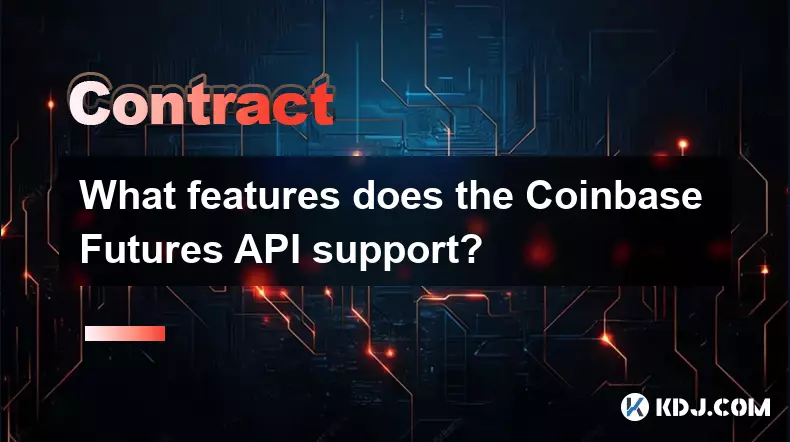-
 bitcoin
bitcoin $109667.069529 USD
-3.03% -
 ethereum
ethereum $3936.685804 USD
-4.07% -
 tether
tether $1.000493 USD
0.01% -
 xrp
xrp $2.771823 USD
-4.74% -
 bnb
bnb $957.805027 USD
-5.34% -
 solana
solana $196.735100 USD
-6.68% -
 usd-coin
usd-coin $0.999727 USD
-0.01% -
 dogecoin
dogecoin $0.227355 USD
-5.12% -
 tron
tron $0.335205 USD
-0.81% -
 cardano
cardano $0.779256 USD
-3.59% -
 ethena-usde
ethena-usde $0.999900 USD
-0.06% -
 hyperliquid
hyperliquid $42.492095 USD
-6.61% -
 chainlink
chainlink $20.501853 USD
-4.34% -
 avalanche
avalanche $28.952606 USD
-11.21% -
 stellar
stellar $0.356038 USD
-3.93%
What features does the Coinbase Futures API support?
The Coinbase Futures API offers advanced trading features like leveraged positions, real-time data streaming, and robust security, enabling automated and algorithmic trading strategies.
Sep 18, 2025 at 10:00 pm

Futures Trading Capabilities
1. The Coinbase Futures API enables users to execute futures contracts across multiple cryptocurrency pairs, allowing traders to speculate on price movements without owning the underlying asset. This functionality supports both long and short positions, giving flexibility in volatile markets.
2. Orders can be placed using various types including limit, market, stop-limit, and take-profit orders. These order types help traders implement complex strategies such as hedging, arbitrage, and risk mitigation based on real-time market data.
3. Leverage options are available through the API, permitting traders to amplify their exposure with borrowed funds. Different leverage levels are supported depending on the contract and market conditions, enabling tailored risk management approaches.
4. Position management tools allow for dynamic adjustments including position closing, partial liquidation, and margin top-ups. These features ensure that traders maintain control over their open positions even during rapid price swings.
5. Real-time access to order book depth and trade history provides essential insights for algorithmic trading models. High-frequency traders benefit from low-latency data feeds and execution paths integrated into the API structure.
Authentication and Security Features
1. Secure authentication is handled via HMAC-SHA256 signatures using API keys, secret keys, and optional passphrases. Each request must be signed and timestamped to prevent replay attacks and unauthorized access.
2. IP whitelisting is supported to restrict API usage to predefined addresses. This adds an additional layer of protection against misuse, especially for institutional clients managing large portfolios.
3. Rate limiting is enforced per endpoint to prevent abuse and ensure platform stability. Users receive clear HTTP status codes when thresholds are exceeded, allowing them to adjust their calling patterns accordingly.
4. Two-factor authentication (2FA) is required during API key creation, reinforcing identity verification. Keys can also be revoked or regenerated directly from the user dashboard if compromised.
All data transmitted between client and server is encrypted using TLS 1.2 or higher, ensuring confidentiality and integrity of sensitive trading information.Data Streaming and Market Feeds
1. WebSocket support allows continuous streaming of tick-level market data including bids, asks, trades, and funding rates. Subscriptions can be customized per product or group of products for efficient bandwidth use.
2. Heartbeat mechanisms are built into the WebSocket connection to monitor liveness and trigger reconnection logic when needed. This ensures minimal disruption in time-sensitive trading operations.
3. Snapshot and delta updates are provided for order books, reducing initial load times while maintaining accuracy. Clients can reconstruct full order book states incrementally using sequence numbers.
4. Funding rate notifications are pushed in real time, helping perpetual contract traders anticipate cost changes associated with holding leveraged positions overnight.
5. Candlestick data at multiple intervals (e.g., 1min, 5min, 1hr) is accessible via both REST and WebSocket interfaces, supporting technical analysis and backtesting workflows.
Risk Management and Account Controls
1. Margin requirements and liquidation prices are calculated server-side and exposed through dedicated endpoints. Traders can retrieve these metrics programmatically to avoid unexpected position closures.
2. Portfolio isolation modes let users separate margin pools by strategy or asset class. This prevents cross-contamination of risk across unrelated trading systems.
3. Daily and weekly settlement reports are available via API download, aiding compliance and audit processes. Institutional users leverage this data for reconciliation and performance tracking.
Automatic deleveraging protection is implemented to minimize forced liquidations during extreme volatility, preserving capital efficiency under stress scenarios.4. Insurance fund balances and health indicators are published regularly, offering transparency into system-wide risk buffers designed to cover shortfall events.
Frequently Asked Questions
How do I enable testnet access for the Coinbase Futures API?Testnet environments are available for developers to simulate trading without risking real funds. Access requires registration through the developer portal and activation of sandbox mode using designated endpoints and credentials.
Can I automate position scaling with trailing stops via the API?Trailing stop orders are not natively supported but can be emulated by combining WebSocket price feeds with conditional logic in your application. You monitor price movement and dynamically update stop-loss levels based on predefined offsets.
Is there a way to retrieve historical funding payments programmatically?Yes, the API includes an endpoint specifically for fetching past funding payments associated with open positions. This data covers payment timestamps, rates, and amounts settled in the respective quote currency.
What happens if my WebSocket connection drops during active trading?Upon reconnection, the API sends a catch-up message containing missed events within a defined window. Applications should validate sequence numbers and request snapshots if gaps exceed tolerance thresholds to maintain consistency.
Disclaimer:info@kdj.com
The information provided is not trading advice. kdj.com does not assume any responsibility for any investments made based on the information provided in this article. Cryptocurrencies are highly volatile and it is highly recommended that you invest with caution after thorough research!
If you believe that the content used on this website infringes your copyright, please contact us immediately (info@kdj.com) and we will delete it promptly.
- Big Rocking Horse, Coin, and Ice Cream: An Aussie Icon's Sweet Ride
- 2025-09-26 10:45:16
- Pi Network, Price Forecast, and the Meme Market: A New York Minute
- 2025-09-26 10:25:14
- AIXA Miner: Revolutionizing Bitcoin Mining with Cloud Solutions
- 2025-09-26 10:45:16
- Mid-Cap Altcoins: Crypto Buys with Breakout Potential
- 2025-09-26 10:50:01
- BullZilla Presale: Riding the Crypto Wave in September 2025
- 2025-09-26 10:50:01
- Litecoin ETF Buzz, XRP Breakout Dreams, and BlockDAG's Deployment: Crypto's Wild West in '25
- 2025-09-26 10:50:01
Related knowledge

How do I enable the "scalping-only" mode for Cardano (ADA) contracts?
Sep 24,2025 at 03:19am
Understanding Scalping Strategies in Crypto Derivatives1. Scalping in cryptocurrency trading refers to executing multiple short-term trades within min...

What is the maximum position limit for Cardano (ADA) contracts?
Sep 23,2025 at 11:00pm
Understanding ADA Futures and Derivatives Market Structure1. Cardano (ADA) futures contracts are offered by several major cryptocurrency derivatives e...

What is the maker fee for Cardano (ADA) contracts?
Sep 26,2025 at 09:01am
Understanding Maker Fees in Cardano (ADA) Contracts1. The concept of maker fees applies broadly across decentralized exchanges and smart contract plat...

How can I view open interest in Cardano (ADA) contracts?
Sep 24,2025 at 07:36am
Understanding Open Interest in Cardano Derivatives1. Open interest refers to the total number of outstanding derivative contracts, such as futures or ...

What is the function of the insurance fund in Cardano (ADA) contracts?
Sep 24,2025 at 02:18am
Understanding the Role of Insurance Funds in Cardano Smart Contracts1. The insurance fund within Cardano's ecosystem is not a native feature directly ...

How can I view historical transaction records for Cardano (ADA) contracts?
Sep 24,2025 at 04:01pm
Understanding Cardano's On-Chain Data Structure1. Cardano operates on a proof-of-stake blockchain that records all transactions in blocks secured thro...

How do I enable the "scalping-only" mode for Cardano (ADA) contracts?
Sep 24,2025 at 03:19am
Understanding Scalping Strategies in Crypto Derivatives1. Scalping in cryptocurrency trading refers to executing multiple short-term trades within min...

What is the maximum position limit for Cardano (ADA) contracts?
Sep 23,2025 at 11:00pm
Understanding ADA Futures and Derivatives Market Structure1. Cardano (ADA) futures contracts are offered by several major cryptocurrency derivatives e...

What is the maker fee for Cardano (ADA) contracts?
Sep 26,2025 at 09:01am
Understanding Maker Fees in Cardano (ADA) Contracts1. The concept of maker fees applies broadly across decentralized exchanges and smart contract plat...

How can I view open interest in Cardano (ADA) contracts?
Sep 24,2025 at 07:36am
Understanding Open Interest in Cardano Derivatives1. Open interest refers to the total number of outstanding derivative contracts, such as futures or ...

What is the function of the insurance fund in Cardano (ADA) contracts?
Sep 24,2025 at 02:18am
Understanding the Role of Insurance Funds in Cardano Smart Contracts1. The insurance fund within Cardano's ecosystem is not a native feature directly ...

How can I view historical transaction records for Cardano (ADA) contracts?
Sep 24,2025 at 04:01pm
Understanding Cardano's On-Chain Data Structure1. Cardano operates on a proof-of-stake blockchain that records all transactions in blocks secured thro...
See all articles










































































